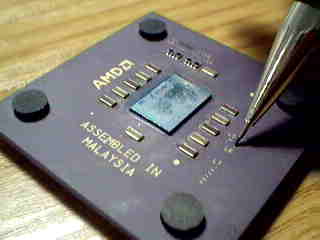Bij AnandTech is een artikel verschenen over problemen met net het overklokken van de KT133A chipset. Door de multiplier van een Socket A processor te verlagen en de FSB op te hogen van 100 naar 133MHz zou het in principe mogelijk moeten zijn om betere prestaties uit elk systeem te krijgen. Toch werkte deze truc niet bij iedereen. Tot nu toe was er geen echte verklaring voor, maar in dit artikel geeft men uitleg en zelfs een oplossing. Het blijkt namelijk dat tijdens het laden van het BIOS (met de nieuwe multiplier) de default multiplier in werking is. De processor draait dus een paar seconden 33% hoger dan de ingestelde waarde en dat zorgt er in veel gevallen voor dat de PC niet verder kan opstarten. Dit gebeurt alleen op moederborden met een FSB jumper zonder multiplier dipswitches. Een oplossing voor 'slachtoffers' van zo'n moederbord is het handmatig instellen van de multiplier aan de hand van de L6 bruggen en dat wordt dan ook uitgebreid beschreven:
So theoretically in order to make your chip having a lower multiplier, you just need to follow the Frequency Selection chart in the article from Tom’s Hardware. However, when modifying those bridges, oftentimes the hardest thing to do is to cut one of these bridges. Connecting an already broken bridge is simple enough, since it can be done with a mechanical pencil or a conductive pen. Cutting a bridge can actually be dangerous, as the tools required to do so could actually damage the CPU.
Therefore, the ideal solution would minimize the number of bridges that need to be cut, while at the same time achieving our goal of lowering the default clock multiplier. Back in our AMD Thunderbird / Duron Investigation and Overclocking Discussion, we accidentally thought that the jumpers on the FIC AD-11 were in charge of the FID pins, when in fact they controlled the BP_FID pins. The result of that is we weren’t able to raise the multiplier any higher than the default, even though we could lower the multiplier.
That piece of information gave us a big hint - even if the FID pins and the BP_FID pins do not match, the chip will still work. So it is possible for us to modify either set of bridges to lower the multiplier. Since the L6 bridge controls the default clock multiplier and it has only four pairs, it is the best candidate for us to play with. Keep in mind that our goal is to let the chip boot up at a lower multiplier for a few clock cycles so that the settings from the BIOS come in and take charge.

